Dubarry Cauliflower Cream Soup is a French classic, the crème de la crème of French soups. This soup also has a hot royal romance behind it, which simmered away between Versailles and Paris in the 18th century.
Discover what is Dubarry soup, its origin, who was Madame du Barry plus the authentic recipe.
A seemingly simple soup with so much richness. No wonder this was crafted for a favorite mistress. Love the history and the soup.
Jennifer
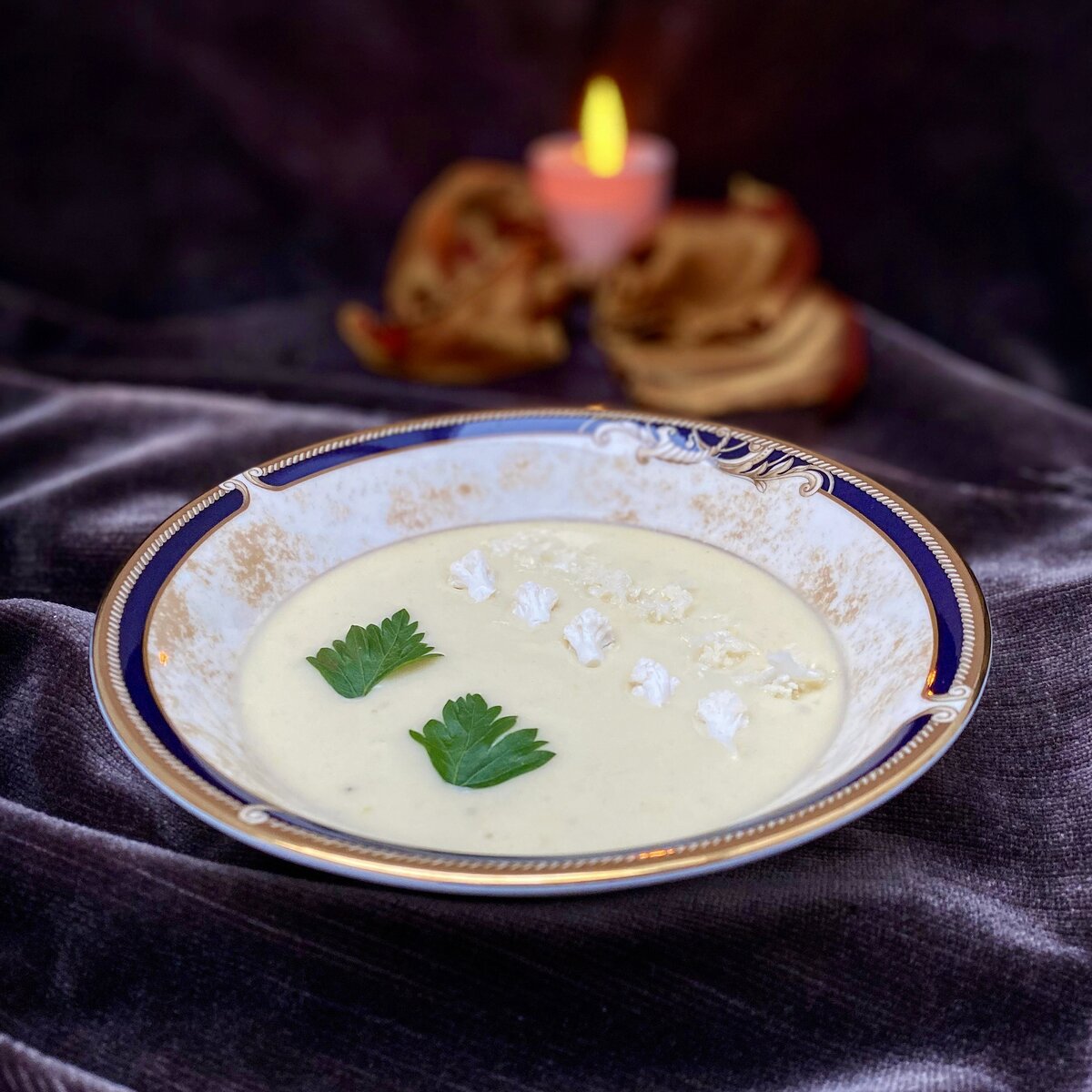
Why is it Called Crème Dubarry?
Known as Crème Dubarry or Velouté du Barry, Dubarry Cauliflower Cream Soup is a French classic.
It was created for Madame du Barry, King Louis XV's last and favourite mistress, who adored cauliflower.
Turning to my French Larousse Gastronomique dictionary, anything called 'Du Barry' in French cuisine contains cauliflower (chou fleur in French) - from a simple salad to the most famous Crème Dubarry, often served on winter menus in chic Parisian restaurants.
Why Dubarry? This rich cream of cauliflower soup gets its name from the so-called Comtesse du Barry, who adored the humble chou-fleur. I say, so-called, as Madame Jeanne wasn't really a countess.
Who was the Madame du Barry?
Gourmet Madame, then made Comtesse du Barry, was the last mistress and favourite of King Louis XV. (Not to be confused with the chain of Parisian boutiques, Comtesse du Barry. Known for its gourmet tinned meals of foie gras or truffles.)
Madame was renowned for her beauty, her blond curls, her blue eyes, her love for luxury - and her way of wrapping her little finger around aristocratic, influential men.
We were intrigued to visit part of her residence, gifted by Louis XV, in Louveciennes in Les Yvelines (only 10km west of Paris). Alas, the domain is private and closed to the public - but, once a year for just a couple of hours, guided visits are arranged in May by the Office de Tourisme de Boucles de Seine. As photos are not permitted inside the residence, my photos are restricted to the lush grounds.
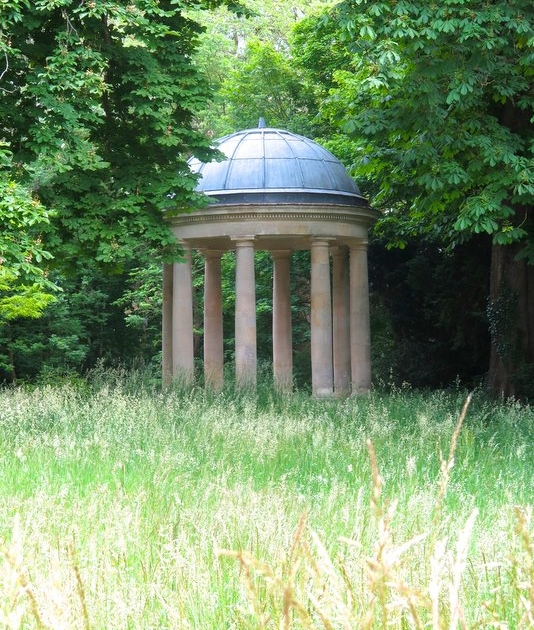
Louveciennes was host to painters such as Madame Vigée Le Brun (who painted 3 portraits of Mme du Barry) and Impressionists, Pissaro and Sisley.
It's another lovely walk in the area, as part of the 4 Impressionist Walks by the Seine (see my post on the Renoir walk from Chatou to Carrières-sur-Seine).
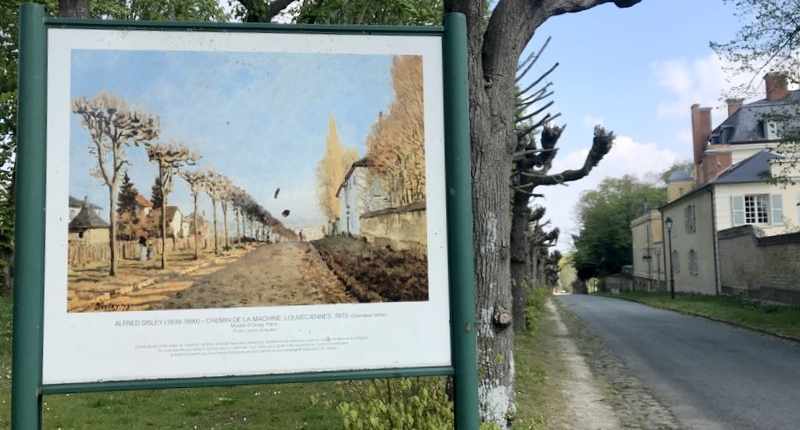
Outside Madame du Barry's residence was the enormous water pipe - still camouflaged today - in the lush countryside. Apparently the noise of the water from the pipes distressed Madame.
It transported water to the Versailles fountains from the Seine river via the Machine du Marly. This incredible feat of engineering coped with Louis XIV's luxurious tastes for the palace but I bet Madame would have loved to stuff some cauliflower in it!
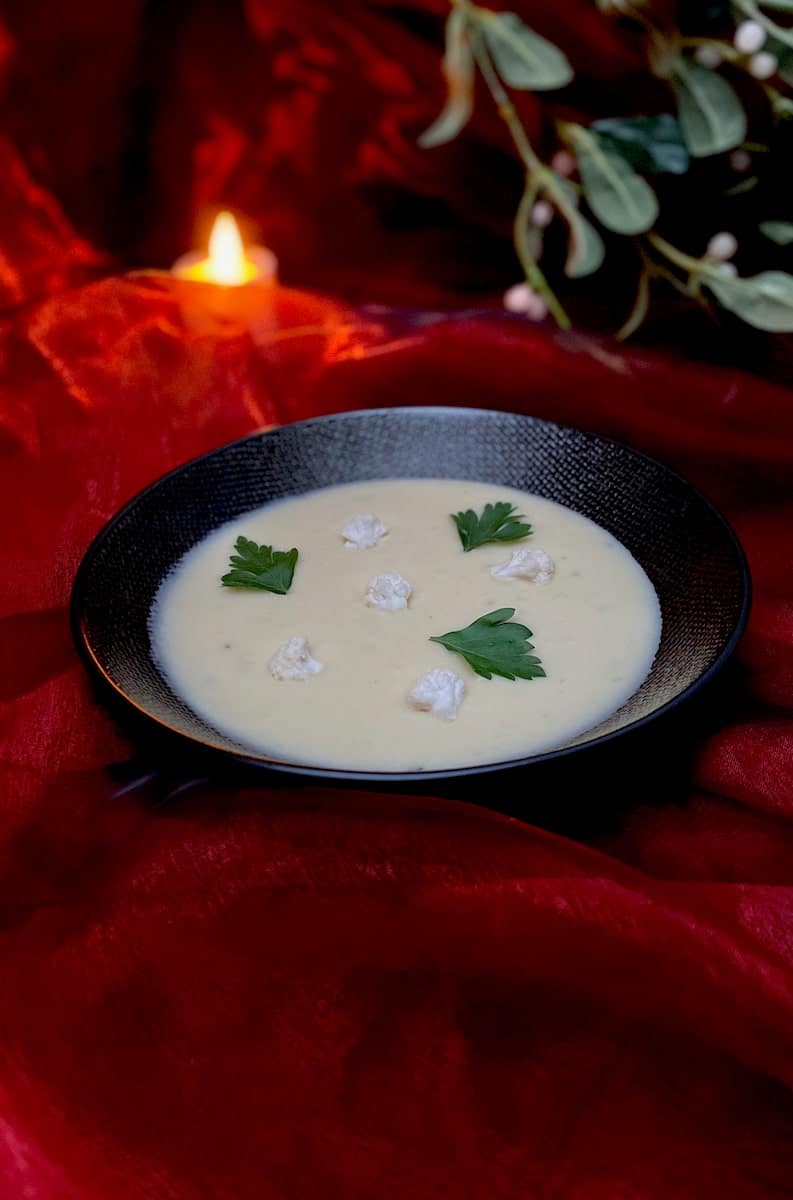
Madame du Barry or Countess?
The Countess wasn't always a countess. Raised as Jeanne Bécu in a convent (since her mother had a dangerous liaison with a Franciscan monk), she then worked her way up from hairdresser to haberdashery in Paris. It was the wealthy, influential casino owner, Jean-Baptiste du Barry that changed her direction as Mademoiselle.
Jeanne became his mistress, plus mistress to others too in royal circles - right up to Louis XV. One problem: she wasn't appreciated as being a non-aristocrat in French society and the king couldn't see her unless she had a title. The King solved this by ensuring her marriage to Du Barry's brother, the Count Guillaume du Barry in 1768. This gave her title of Countess - even if she was, and still is, referred to as Madame.
After King Louis XV's death in 1774, Madame du Barry wasn't permitted to stay in the court (Queen Marie-Antoinette thought of her as rather common - read vulgar). So she stayed here, lavishly entertaining in her oak-panelled dining room with the best creamy cauliflower soup in France.

Adding Egg Yolks to Cauliflower Soup (Crème Dubarry)
It was apparently under this enormous tilleul or lime tree that the aging King Louis XV and young Madame du Barry would sip chocolat together in Louveciennes. Although the luxury of chocolate (as a drink) was brought to the French court via Louis XIII then Louis XIV, it was Louis XV that was reputed to have loved chocolate the most.
Considered an aphrodisiac drink, the king prepared his own chocolate love potion (see the chocolate recipe from Versailles Palace). He added an egg yolk to his chocolate to ensure its extra smooth texture. Could he have been inspired by the egg yolks in Madame du Barry's best cauliflower soup?
Enough of the history of Dubarry but the French are fascinated about her story. Now on to making that Crème Dubarry!
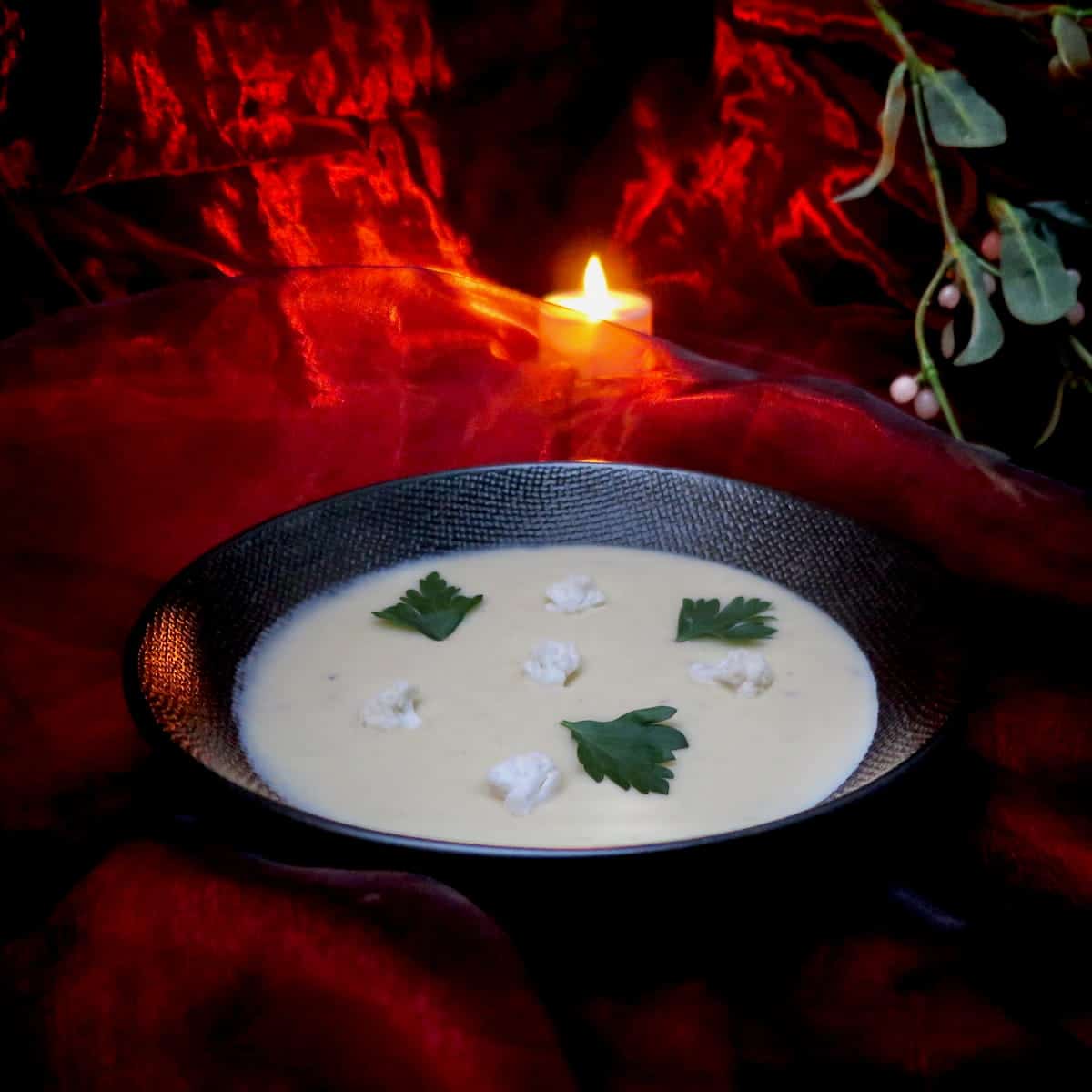
Classic French Method of Making Dubarry Cream
Keeping with rich, velvety textures, Madame du Barry's chef, Louis Signot, created a soup with Jeanne's favourite vegetable. It was so simple yet sophisticated enough for royal approval.
According to the French culinary legend, Auguste Escoffier in his Guide Culinaire (page 34), there are two versions of Dubarry Cauliflower Soup.
- One is a cream based on milk, cream and potatoes;
- the other Crème Dubarry or Vélouté is based on a white roux (butter and flour) with added egg yolks and cream at the end of cooking.
Seen as Louis XV's chocolate potions included egg yolks, I'm guessing the King cracked for the latter version. So I'm sticking with this.
One recipe I got at our local market, however, used a whopping 6 egg yolks. Instead I prefer the recipe as follows, as it's silky enough without being too overwhelmingly rich to start off a meal.
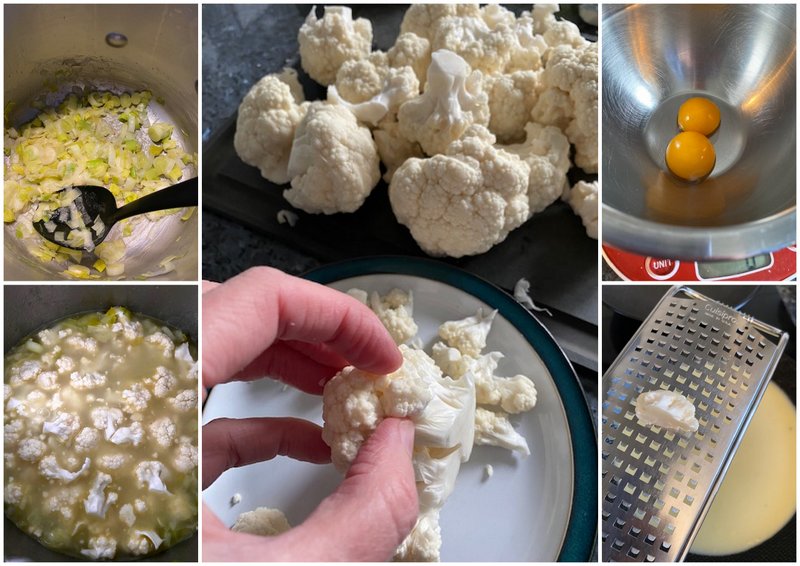
How to Thicken Cauliflower Cream Soup ( Dubarry)
Normally I would use a potato to thicken soup but this French recipe uses flour instead.
Make a white roux by adding butter, gently cooking the leeks and adding the flour to make a paste - then stir in the stock and tiny cauliflower florets. Also use this method for this creamy Mushroom Cappuccino.
All of the bitter cauliflower stalk is discarded. Small, digestible florets are used, cleaned first in a mixture of water with a little vinegar. Keep the smallest florets aside for the garniture.
Once mixed/blended using a stick blender, create the soup's liaison (pun totally intended with that romantic history).
The mix of egg yolks and cream are gradually blended/liaised into the soup. Add some of the soup liquid to the cream, then add the whole lot to create the Dubarry cream.
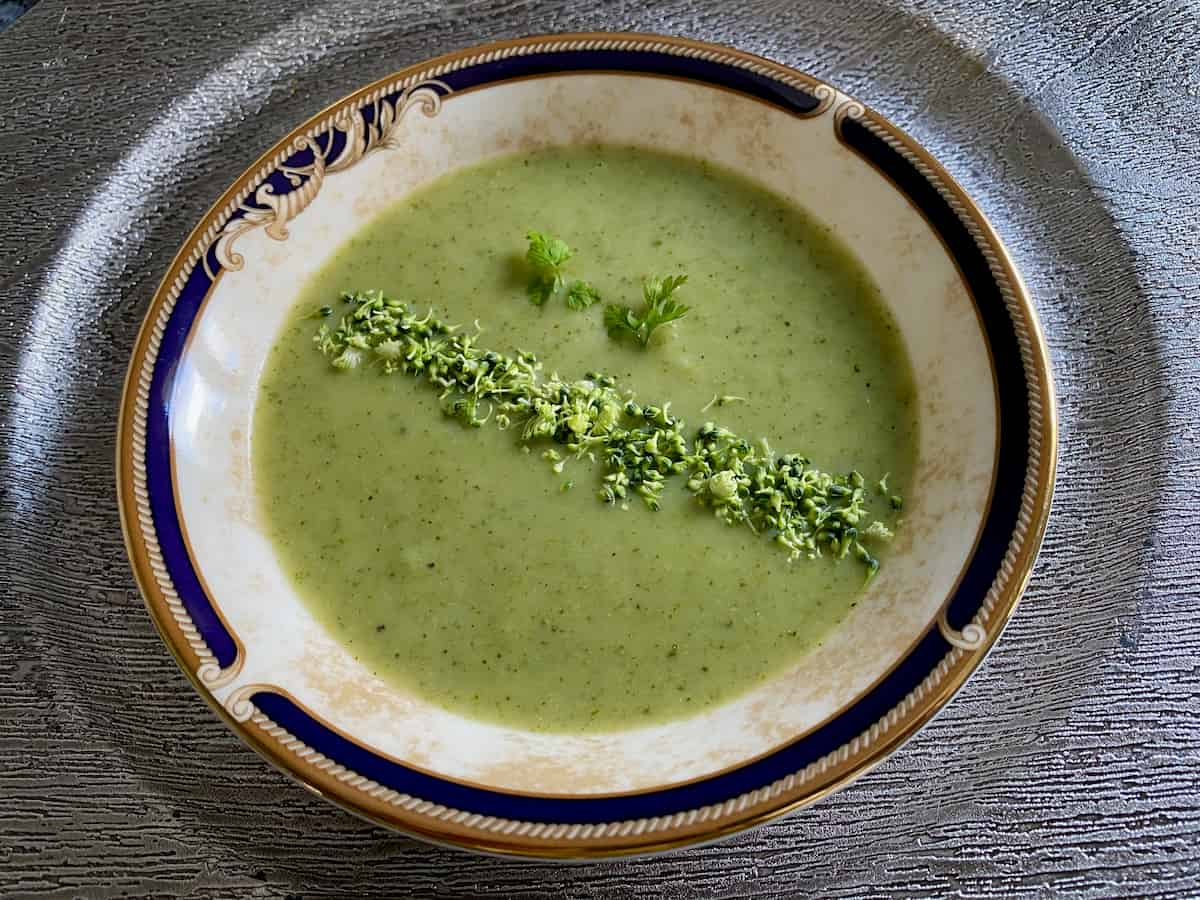
Cauliflower Cream Soup - Dubarry French Garniture
The garniture is just as important as the soup! The classic, according to Auguste Escoffier in his Guide Culinaire (1903), is to add tiny cauliflower florets (pre-cooked à l'anglaise - English-style in boiling water) and some chervil.
Even easier, sprinkle with the smallest raw florets: the mini crudité-style cauliflower adds a magnificent crunch! Grate a cauliflower floret to top the soup.
Less Classic Garniture: Seared scallops - see recipe for Curried Cauliflower soup.
For the ultimate dinner scandal, serve the Dubarry Cauliflower Cream with a mini curry macaron. The recipe is in my book, Mad About Macarons - see more how to serve savoury macarons. I'm sure Madame would have approved, even if just for the mischievous fun of it.
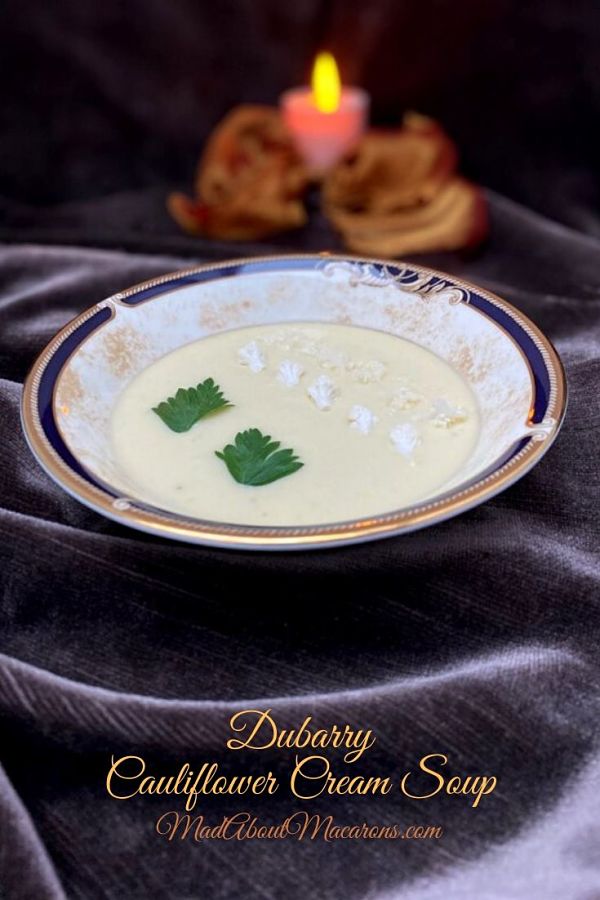
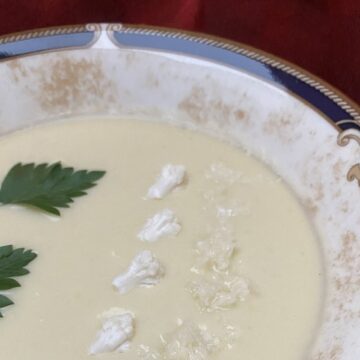
Cauliflower Cream Soup (Crème Dubarry)
Ingredients
- 700 g (1.5lb) organic cauliflower (prepared after stalk/leaves removed)
- 2 leeks (white part only) sliced
- 55 g (2oz/ 4 tbsp) butter (unsalted)
- 2 tablespoon flour (all purpose)
- 1 litre chicken stock * (stock mixed with hot water)
- 2 egg yolks organic
- 100 g (3.5oz/ ⅓ cup) half-fat cream or crème fraîche
- ½ teaspoon each of salt (fleur de sel) & freshly ground pepper
- Fresh chervil or flat-leaf parsley optional, for decor
Instructions
- Remove the bitter stalk and leaves from the cauliflower, reserving the florets. Wash in a mixture of water with a dash of vinegar and set aside. Clean and slice the leeks.
- In a large, heavy pot, melt the butter then sweat the leeks in it until translucent but not brown. After 4-5 minutes, add the flour and stir together well until a smooth paste forms. Gradually whisk in the hot stock. Add the cauliflower florets, setting aside a few of the raw, smallest florets for decor. Bring to the boil.
- Cover, turn down the heat and leave to simmer gently for about 25 minutes.
- Towards the end of cooking, in a separate bowl, whisk the egg yolks with the cream, salt and pepper. Add a ladle-full of the soup's hot liquid to temper and whisk together. Using a hand-mixer, blitz the soup until well blended.Gradually whisk in the yolk and cream mixture until the soup is smooth. Adjust seasoning if necessary.
- Serve topped with tiny raw cauliflower florets (or grated), chopped fresh chervil or parsley.


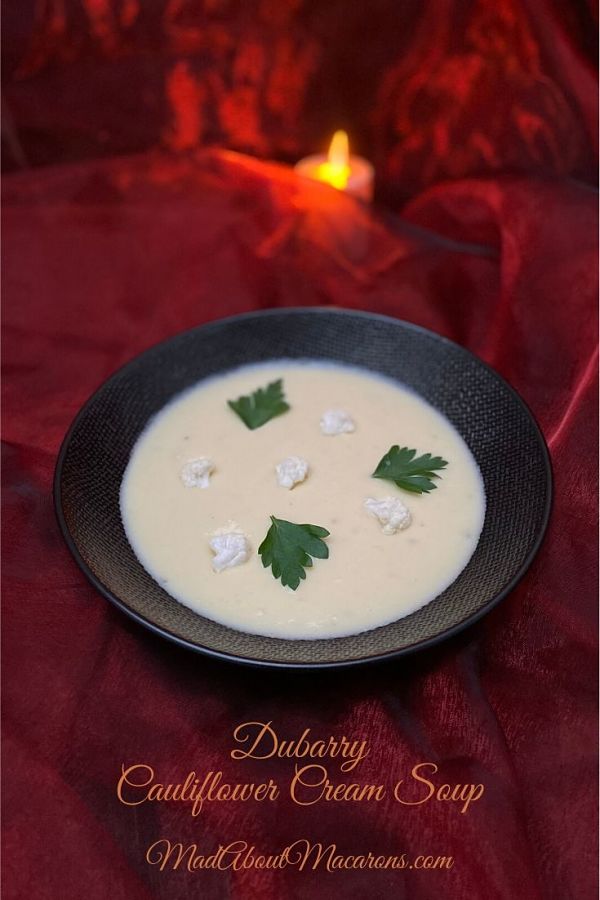


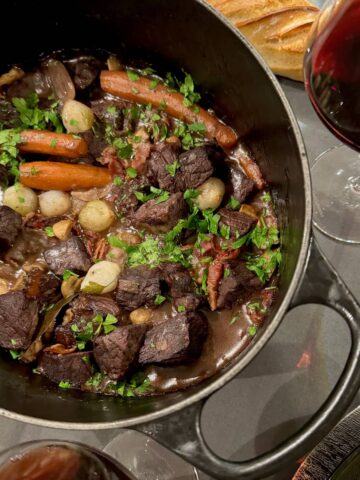
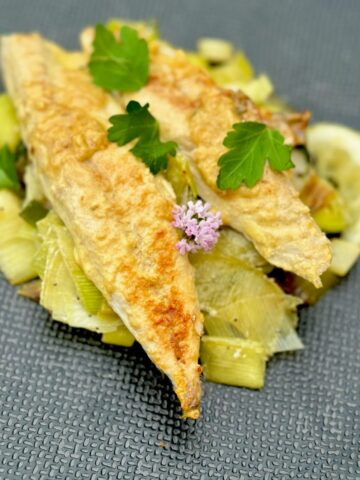

Lorraine
Absolutely delicious, a keeper.
Jill Colonna
Thanks - so happy you've tried this, Lorraine.
Sally Ferguson
Can you freeze this soup
It sound delicious and the history lesson was pretty good
Jill Colonna
I haven't ever frozen this soup, Sally but yes it would freeze no problem. I'd use it within 2-3 months. Let me know how you like the recipe!
Thomasina
Thank you for the history lesson Jill. I have always wondered who Madame du Barry was as seen the name in Paris. I love cauliflower but sometimes it lacks flavour but your recipe is tops.
Jill Colonna
Here's to cauliflower soup with tons of flavour with a wee story behind it. Thanks, Thomasina.
Jacqueline McColl
I just made this soup and it's absolutely wonderful. I used cashew cream for heavy cream. This recipe will be on my perfect recipes list. Thankyou !!
Jill Colonna
So thrilled to hear it's one on your perfect recipe list. Thanks so much, Jacqueline. Have a lovely weekend!
Lisa
This is such a departure from my favorite cauliflower soup. I will definitely give this a try. I love the history behind it. It will be hard to not use dill weed and caraway in it!
Jill Colonna
Hi Lisa,
Sounds like you'll just have both recipes to enjoy that are different. Please do give this a try and let me know what you think. Merci x
Martin
I made this yesterday using broccoli. Absolutely brilliant. Definitely on my go-to list now.
Jill Colonna
So happy you like this - yes, I love it also made with broccoli - let's not tell any gourmet French Dubarry gendarmes lol!
Kim Robertson
I made this for a group, I used plant based milk due to a dairy allergy. It was delicious, and I will certainly be making this again.
Jill Colonna
Good to know that it's good also with plant-based milk. Thanks for your feedback, Kim.
Jennifer Muller
A seemingly simple soup with so much richness. No wonder this was crafted for a favorite mistress. Love the history and the soup.
Jill Colonna
Thanks so much for your lovely words, Jennifer. Much appreciated!
Janice Pattie
Such a delicious soup. with so much history! I like the sound of a bit of crunch in the cauliflower soup, I do enjoy a bit of raw cauliflower.
Jill Colonna
So glad you like "le crunch" in there, Janice. It's like serving up crudités at the same time!
CAMILLA HAWKINS
I love cauliflower soup and this one sounds super creamy and delicious, must try!
Jill Colonna
Thanks Camilla. I'm like you, love Cauliflower soup - but this slightly different method of preparation is such a wonderful discovery!
All That I'm Eating
Well, I didn't know that! Dubarry cauliflower soup sounds like it needs to be in my kitchen soon, it's perfect for this time of year, particularly with the addition of cream.
Jill Colonna
Thank you. Isn't it interesting? Love a bit of a story behind a recipe and to think it was just up the road from us! It's a very interesting addition with the yolks, too.
Thomasina
I am intrigued by the Countess also - fascinating reading Jill. AND I love cauliflower so your recipe will go down well in our house. You certainly do live in an area steeped in history so thank you for sharing.
Jill Colonna
Thanks, Thomasina - anything to make you bowl over a soup recipe with a wee bit of history!
Christina Conte
What a lovely post and recipe, Jill! I love the history behind this soup and seeing the photos (too bad none were allowed inside). Even the pipe picture is SO cool! You are very lucky to be steeped in so much history. I'm lucky if I see a house that was built in the early 1900s here. I'm not like the Countess as I'm not a big fan of cauliflower, but I think I may like this soup! Looks so creamy! 🙂
Jill Colonna
I think the kids are fed up with me saying how much I feel lucky to live in this area - it's incredible to think of all those personalities walked around here and there's always some kind of story to tell, whether royal or Parisian or both! Isn't it funny? I'm not the greatest of cauliflower fans either but this soup has changed my ideas on the vegetable that frankly gets a bad name really (normally I have to put curry in it, lol!) I love its consistency. Would never have thought of adding yolks. Thanks for your lovely words!
Betty
Looks lovely, Jill and we will definitely be trying it out. We love cauliflower and so I'm glad for another way of using it. And thank you so much for the informative post about the rather notorious Madame DuBarry as well!
Jill Colonna
This woman intrigues me, Betty. Thanks for joining in the chou-fleur fun!